Average Car Payment and Auto Loan Statistics: 2025
The average car payment for new vehicles was $742 per month in the fourth quarter of 2024, down 0.1% from Q4 2023. Meanwhile, average car payments for used and leased vehicles decreased by 1.9% and 1.6%, respectively, over the same period.
LendingTree looked at payments, originations, term lengths, delinquencies and more to get a full picture of U.S. auto loan debt and trends. Here’s our 2025 roundup of auto loan statistics.
Auto loan statistics in 2025: Average car payments to most popular models
- Average car payments for new, used and leased vehicles declined year over year. Average car payments for new vehicles decreased by 0.1%, according to Q4 2024 Experian data. In the same period, average car payments for used and leased vehicles decreased by 1.9% and 1.6%, respectively. That puts average monthly car payments at $742, $525 and $600, respectively.
- The price of used cars and trucks increased. Used car and truck prices are up 0.8% year over year, according to the February 2025 U.S. Bureau of Labor Statistics (BLS) consumer price index, while new vehicle prices dipped 0.3%. Americans borrow an average of $41,572 for new vehicles and $26,468 for used vehicles, according to Experian.
- Auto loan debt is the second-largest category behind mortgages. Overall, Americans owe $1.655 trillion in auto loan debt, according to the Federal Reserve Bank of New York, accounting for 9.2% of American consumer debt.
- Americans took out $175.1 billion in new auto loans in Q4 2024. By age, Americans ages 18 to 49 took out $102.9 billion in auto debt during the quarter, according to the New York Fed, compared with $68.6 billion among those 50 and older.
- Americans are taking many years to pay back their auto loans. The average auto loan term is 68.0 months for new cars, 67.2 months for used cars and 35.5 months for leased vehicles, according to Experian.
- Auto loan delinquency rates are up compared to a year ago. 4.8% of outstanding auto debt was at least 90 days late in Q4 2024, according to the New York Fed, up 15.8% from Q4 2023. Meanwhile, the percentage of auto loans that fell to 30 days past due was 8.1% in Q4 2024, up 5.1% from 7.7% in Q4 2023.
- Borrowers with prime or super-prime credit scores are responsible for the majority of retail vehicle financing. Borrowers with credit scores of 661 and higher account for 70.8% of retail vehicle financing, according to Experian, versus 14.1% for borrowers with credit scores of 600 or lower.
- The most popular vehicle models consumers considered buying on the LendingTree platform in Q4 2024 were the Ford F-150, Chevrolet Silverado 1500 and Ram 1500. The Ford F-150 maintained the No. 1 spot for the fourth quarter in a row.
Average monthly car payments for new vehicles decrease slightly year over year
The average car payment for a new vehicle is $742 monthly, according to Q4 2024 Experian data — down 0.1% year over year. Used cars have an average monthly payment of $525, down 1.9% over the same period. Meanwhile, new lease payments average $600, a 1.6% year-over-year decrease.
Annual changes in average monthly car payments
Source: Experian State of the Automotive Finance Market, Q4 2023 and Q4 2024.
Those with credit scores of 601 to 660 (in the nonprime or fair ranges) and 501 to 600 (in the subprime or poor and fair ranges) saw the highest average monthly payments for new vehicles, at $775 and $759, respectively.
Average monthly payments by credit score range
Source: Experian State of the Automotive Finance Market, Q4 2024.
You can use the LendingTree auto loan calculator to estimate your monthly car payment.
Used car and truck prices increase slightly
The used car market wasn’t friendlier to consumers as used car and truck prices increased by 0.8% year over year, per the February 2025 BLS consumer price index.
A June 2024 Wall Street Journal article said buyers increasingly believe used cars offer better designs and features that new ones don’t provide.
Meanwhile, new vehicle prices dipped by 0.3% year over year — similar to the 0.1% decrease in the average new car payment over the past year.
Average auto loan amounts for new vehicles remain above $41,000
Average auto loan amounts reached $41,572 for new vehicles and $26,468 for used vehicles in Q4 2024, according to Experian. New vehicle loan amounts rose from an average of $41,086 in the prior quarter, while used vehicle loan amounts rose from $26,091 in Q3.
New car buyers in the prime credit tier (661 to 780) take out the largest loans — $43,695, on average. Borrowers with credit scores in the tier above — super-prime (781 to 850) — take out the most for used cars, $28,712, up from $27,860 the prior quarter.
Average auto loan amounts by credit score range
Source: Experian State of the Automotive Finance Market, Q4 2024.
Americans owe $1.655 trillion in auto loan debt
Overall vehicle debt has increased by 73.3% between Q4 2014 ($955 billion) and Q4 2024 ($1.655 trillion), according to the Federal Reserve Bank of New York.
In those 10 years, the only dip came in Q2 2020 — the first full quarter amid the pandemic.
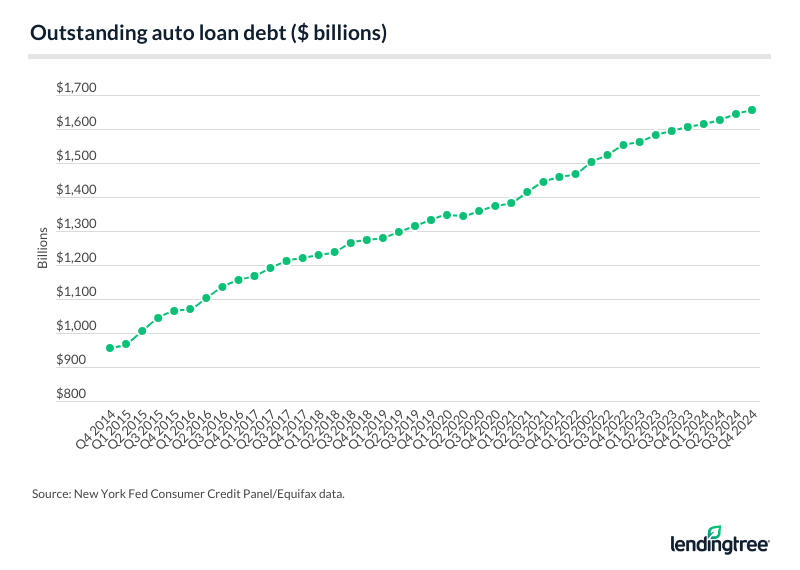
Outstanding auto debt
Source: New York Fed Consumer Credit Panel/Equifax data.
Auto loans account for 9.2% of American consumer debt
While mortgages take the lion’s share of American consumer debt at 69.9% — according to the New York Fed — auto loans account for 9.2%. Auto loan debt ($1.655 trillion) is ahead of student loan debt ($1.615 trillion) as of Q4 2024.
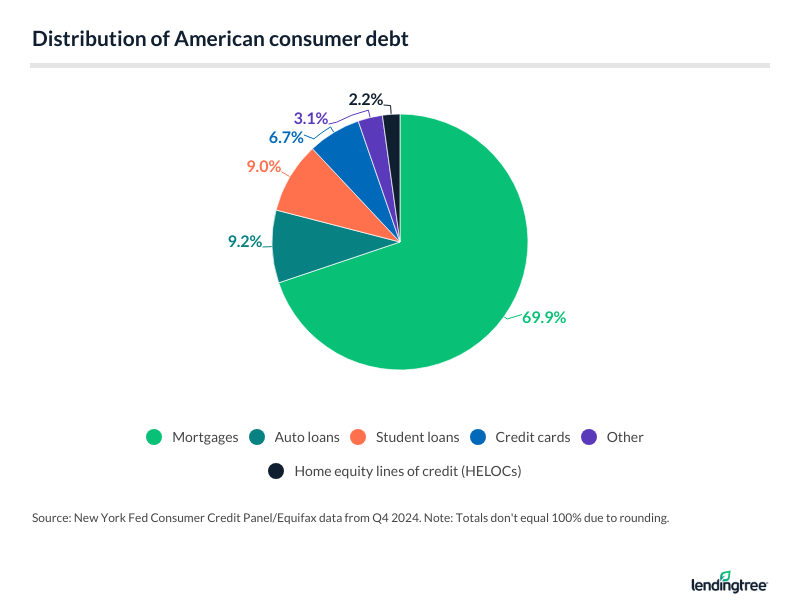
Americans borrow $175.1 billion in 4th quarter of 2024
Americans took out $125.5 billion in auto loans in Q4 2014. Ten years later in Q4 2024, they borrowed far more: $175.1 billion, according to the New York Fed.
Here’s a quarterly look during this period:
Quarterly volume of auto loan originations
Source: New York Fed Consumer Credit Panel/Equifax data.
Americans in their 30s, 40s take out biggest auto loans
Americans in their 30s and 40s took out the largest auto loans in Q4 2024, according to the New York Fed, borrowing $38.7 billion and $38.6 billion, respectively.
Those in their 50s borrowed billions less ($34.1 billion), and those in their 60s borrowed $23.4 billion. Young adults 18 to 29 borrowed more ($25.6 billion) than consumers in their 60s.
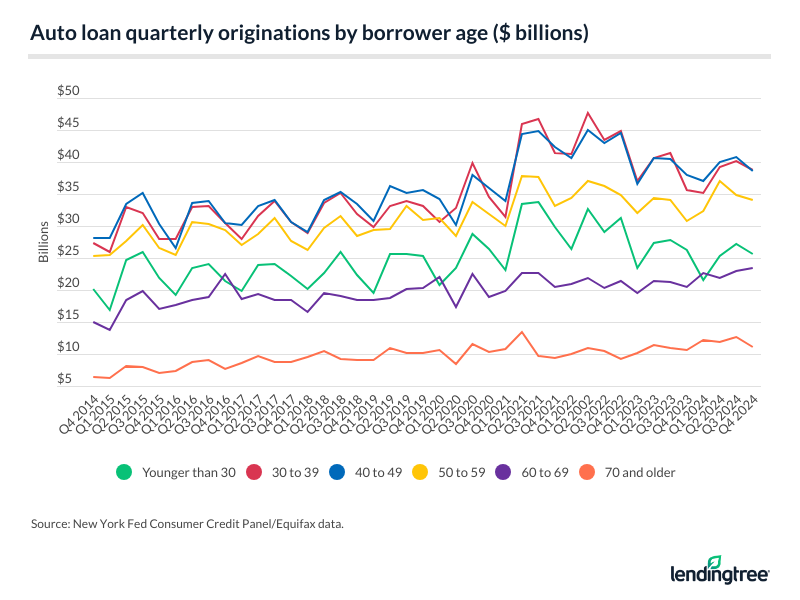
When combined, Americans ages 18 to 49 took out $102.9 billion in auto debt in Q4 2024. That compares with $68.6 billion for those 50 and older.
Americans with highest credit scores take out biggest auto loans
Meanwhile, those with the best credit scores borrow the most. In Q4 2024, borrowers with credit scores of at least 720 took out $93.4 billion in auto loan debt. The remaining credit tiers accounted for $81.7 billion combined, according to the New York Fed.
Auto loan originations by credit score
Source: New York Fed Consumer Credit Panel/Equifax data.
Average auto loan term shows it’s taking time to pay back these loans
The average auto loan term for new vehicles is 68.0 months, or less than six years, according to Experian. Used car loans, despite being significantly smaller on average, are close behind at 67.2 months.
Average term lengths by credit score range
Source: Experian State of the Automotive Finance Market, Q4 2024.
But auto loans for new vehicles are stretching even longer — topping six years — for nonprime borrowers. Middle-tier credit borrowers with scores of 601 to 660 take out the longest new car loans, at an average of 74.3 months. Top-tier credit borrowers with scores of 781 to 850 have the shortest average new car loan term, at 63.6 months.
“That’s such a long time to be stuck paying for a depreciating asset,” LendingTree chief consumer finance analyst Matt Schulz says. “It can have an enormous impact on a family’s finances. That money going toward a car payment isn’t earning interest and funding your emergency savings, your retirement nest egg, a mortgage down payment or your kid’s college fund. Yes, our vehicles are important. In much of the country, you can’t get around without one. And, yes, we love fancy new cars, even new-to-us cars. They’re fun to drive and show off. However, once that initial glow wears off and you’re still making a big monthly payment on that vehicle after five-plus years, it may not seem worth it.”
The average new car lease term is 35.5 months.
Auto loan delinquency rates still below peaks
According to data from the New York Fed, 90-day delinquency rates on auto loans peaked in Q4 2010 at 5.3%, dropping to 4.8% as of Q4 2024.
Meanwhile, the percentage of auto loans that fell to 30 days past due spiked to 10.9% in Q2 2009. Dating to 2011, it remained at or below 8.0% until topping that in Q3 and Q4 2024 (8.1%).
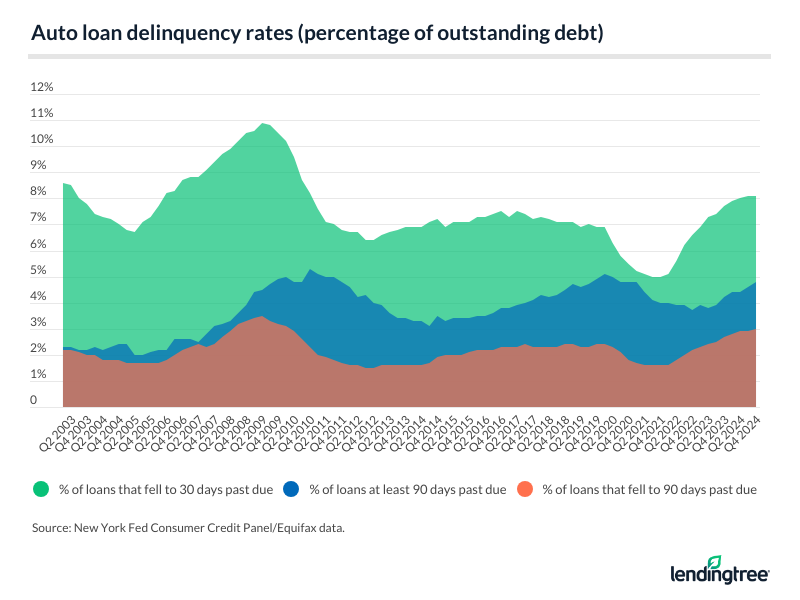
Buyers turn to banks, credit unions the most for auto financing
As of Q4 2024, banks hold the highest market share, at 30.0%, followed by credit unions at 22.3% and captive lenders (manufacturers’ financing arms) at 22.0%.
“Buy-here, pay-here” businesses, often known for predatory lending practices, capture up to 16.1% of the used car financing market. In the used car arena, captive lenders only claim 7.9%.
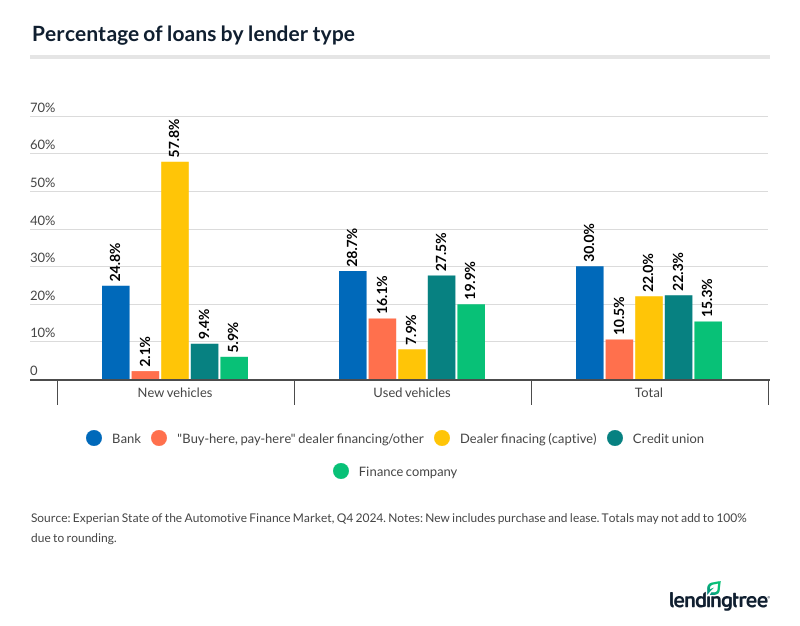
Schulz warns that buy-here, pay-here loans are dangerous. Not only can the sticker price be bigger, but the interest rates can look more like credit card rates than typical auto loan rates, and there may be extra fees. There may be an unusual payment schedule requiring you to pay more often than the typical monthly payment. Some places might even require you to put a tracking device on the car to make it easier to take back if you fall behind on payments.
In short, these should be among the last options you’d consider, but your credit score plays a role in what options are available to you.
“Good credit means more good options, and that’s a big deal,” Schulz says. “You must shop around. If you finance through the car seller, you’re very likely to overpay. Use sites to compare auto loan offers easily. You could also visit multiple lenders online on your own — consider looking at credit unions if you do. Once you’ve found a deal you’re happy with, get preapproved by the lender. That preapproval gives you leverage over the car seller because they know you won’t be happy with a bad offer.”
Sources
- Experian
- U.S. Bureau of Labor Statistics
- Federal Reserve Bank of New York
- LendingTree
Get auto loan offers from up to 5 lenders in minutes
Read More
How to Get a Car Loan With No Credit History Updated August 19, 2022 Even though it may be more difficult to get a traditional car loan with no…Read More
Can I Refinance a Car Loan With Bad Credit? Updated September 29, 2023 It may be possible, especially if you target the right refinance companies. Refinancing could save…Read More